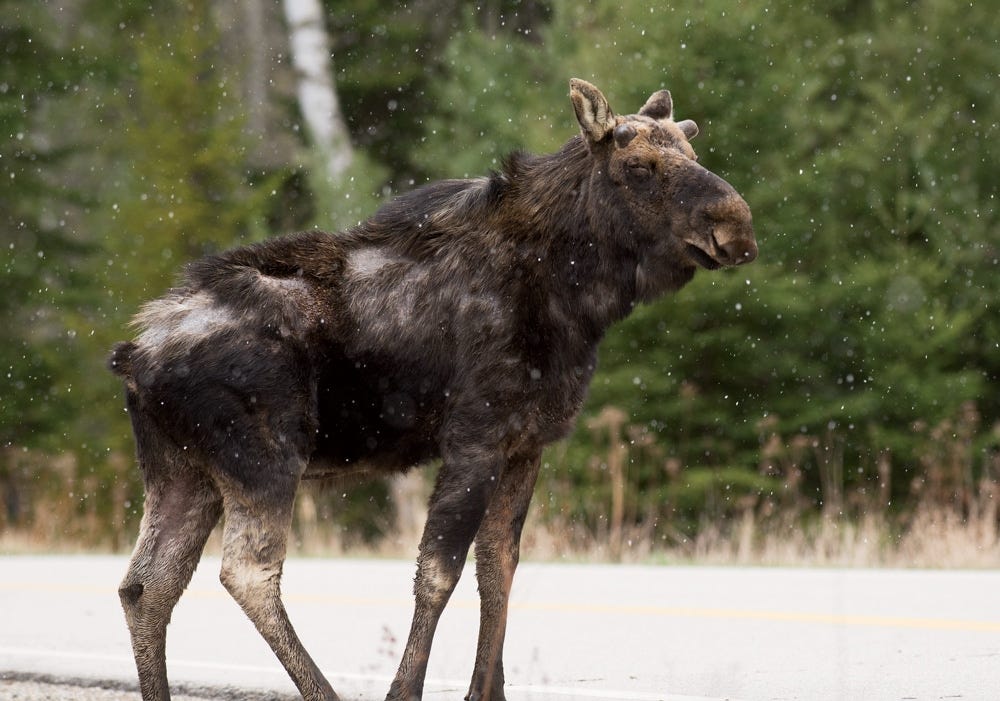Ghosts in the Forest
In June I went on a rewarding birding expedition to the Connecticut Lakes region of Northern New Hampshire. The successional forest was alive with the calls of red-eyed vireos and Swainson’s thrush.
Our leader Bill Gette had led groups up here for 25 years and had always seen moose, often as many as 5 in one evening. This was the prime moose area in New Hampshire yet we saw none.
It reminded me of an experience I had with Ghost Moose on December 13th 2019.
####
Shortly after my father died I put his ashes in a plastic vial and hiked up a steep hill behind our house in Franconia, New Hampshire.
It was mid-December but the weather belied the season. There was no wind and the temperature hovered just above freezing. Flakes of snow drifted quietly out of low gray clouds but the snow-covered flanks of Mount Lafayette were bathed in occasional sunlight.
I paused to watch some snowflakes as they disappeared into the black mysteries of a still unfrozen pond. Then I trudged around the pond to enter a quiet glade. I could hear the snow as it pattered on the forest floor. The wind whispered through the conifers and sunlight filtered through a nave of quietly rustling needles.
A moose antler lay in the path before me. Probably left there by a passing coyote. It was small and puny, gnawed on a bit by mice but nonetheless a sign. The moose had returned to their wintering grounds and changed their eating habits from aquatic vegetation to browsing on bark and twigs.
I continued into the moose yard where the forest floor was a tapestry of lichen and moss delicately embroidered with flakes of perfect white snow.
And now the snow was falling faster forming a veil of shimmering white. A maple tree emerged. Its trunk was scored with fresh wounds from the teeth of a browsing moose. This was a tree that could use some help.
I knelt on the soft cushion of moss and sprinkled my father’s ashes in a perfect circle around the trunk of the ailing tree.
This was resurrection I could believe in, reincarnation I could understand. Next summer my father would live again in the maple’s new green foliage.
Suddenly a branch snapped and a large creature galloped unseen through the woods. I swirled around. My heart was racing. Would I see the bull moose that had eluded me all summer? I clicked on my telephoto lens then stopped. Perhaps it was better if I just remembered his ghostly presence watching over me in the primeval forest.
Many years later I returned to the spot to show a friend that the tree was still thriving. That evening I found what looked like a dog tick crawling up my torso. I was glad I had found the little arthropod before it had burrowed into my skin and doubly happy it had not infected me with any of his tick borne diseases.
It was only when I was doing research for this chapter that I realized it had not been a dog tick but a winter tick, and it had probably fallen off a real ghost moose.
As the climate has warmed, winter ticks that would normally drop off moose in April are increasingly landing on the forest floor rather than on snow where they can freeze to death or be seen and eaten by an insectivorous turkey or other ground feeding birds.
This has allowed Dermacentor albipictus, which formerly lived further south on white-tailed deer to move north and infest moose. But unlike deer that know how to pick off ticks as soon as they find them, moose leave the ticks unmolested until they hang like so many blood-engorged grapes that are too numerous to remove.
Seven out of ten moose calves now die from loss of blood due to tick infestation and older animals rub off their hair in frustration to become mangy white ghost moose. They can barely make it through the year until the winter ticks drop off to lay their eggs in October.
The weakened moose will often be co-infected with brain worms, which cause the moose to become disoriented turning repeatedly in circles until they become paralyzed and die.
Climate change may feel like a vague and distant problem, a problem of sea level rise or carbon dioxide. Then you see the immediacy of this magisterial animal striped bare and confused, circling endlessly until it dies a horrible death amidst New Hampshire’s once untouched primeval forests.




